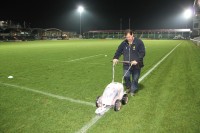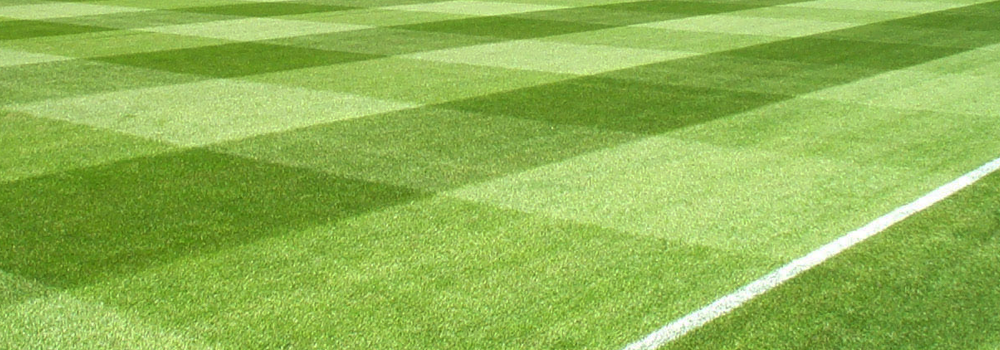
Key things to keep an eye on will be night time temperatures, relative humidity and periods of leaf blade wetness.
Warmth and available moisture are the keys to both grass and fungal pathogenic growth. If night time temperatures fall, growth rates will start to drop off, however lower night time temperatures will lead to heavier morning dews, prolonged periods of leaf blade wetness and increased risk of attack from fungi.
If your local conditions are at the drier end of the spectrum, water stress can quickly creep in, especially on windy days when evapotranspiration rates are higher. This is something which represents a particular risk to newly sown seed which may be in the initial stages of early germination and establishment.
Key Tasks for October

Presentation is important. If it looks well presented, with bands, stripes and a consistent surface, it makes the game more enjoyable for the players.
Most facilities will maintain a height of cut between 30-40mm.
Essential tasks in preparing pitches for play involve, mowing, marking out, divoting, brushing and carrying out aeration.
Training areas will be prone to damage from specific training regimes. Where possible, rotate the areas where these drills take place.
- Continue cutting when necessary and ground conditions permit to encourage good sward density
- Ensure that any equipment used is keenly set to cut
- Regular brushing will keep the air circulating around the base of the plant
- Deep spike to alleviate compaction as and when required
- Continue shallow spiking when the conditions are right (this should only be carried out if the soil is suitably moist) to compliment your deep spiking.
- Keep your spiking regime flexible, alternating between surface spiking, deep spiking and slitting
- Hand fork goalmouth and centre circle areas, if difficult to get onto the pitch with machinery
Try to keep the top 100mm free draining; this can be achieved by regular spiking with solid or slit tines to a depth of 150mm or more.
Divoting is crucial, so start as you mean to go on. At this stage of the season, the addition of seed mixed with a little topsoil will help to repair any deep scars. Repair damage using a fork to close up scars and make sure divots are replaced and firmed into surface to give roots a chance to take hold again.
Oversow sparse or bare areas. Use germination sheets to aid this process but remove the sheets regularly to check for disease. Remember that, without good seed to soil contact, the operation is useless. Ensure you use new seed as old material may not give you the required germination rates.
Marking out
- Keep your linemarker clean
- Keep string lines taut when marking out to avoid deviating from the straight
- Ensure that right angles are correctly formed. Use the 3:4:5 triangle method. The bigger the triangle at the start, the more accurate the pitch will be
Before the match
- Check that the pitch is level and safe for play
- Check for and remove debris (glass, stones etc.)
- Ensure the surface is firm and not saturated, correctly marked out, and that the posts are safe and secure
Post match
- Replace divots, even if it’s just the worst affected areas - it will make a difference!
- Dragmat/brush/harrow to restore playing surfaces
- Remove debris from the playing surface with a rotary mower
Weekly checks:
- Check goals and padding
- Check team dugouts are stable and anchored securely. Make sure that they are tidy and free from litter
- Repair and maintain fence lines
- Sweep up/vacuum fallen leaves




Cooling temperatures, shorter days and longer nights, and heavy dews inextricably lead to reduced recovery growth, fungal pathogens and worm casts. October truly is the middle of Autumn and the steady march towards winter gathers pace. That said, October can still throw up some sunnier and drier spells, not to mention vibrant autumn colour, so all is not lost for the month. It does undoubtedly represent a time of change for turf managers as the plants needs adjust with the environmental conditions.
Nutrition
Accordingly, nutrition geared towards growth should be placed on the back burner. Organic fertilisers are best phased out any time after the start of the month as the release of nitrogen is inhibited once soil temperatures fall below 10 ◦C.
Nitrogen, the key driver for growth, is in much lower demand within the plant and forcing growth with nitrogen has its risks, but it is important to maintain adequate potassium levels.
Traditionally, accepted wisdom has been preventative applications of iron sulphate throughout the autumn and winter. The latest research demonstrates that iron sulphate statistically performs no better than control when used in this manner and, when used curatively, only reduces disease by 40-50%. Furthermore, iron sulphate is acidic and, when applied to the leaf, can actually weaken the cell structure. Phosphite is a much better option to use in this manner and calcium is the element responsible for cell wall thickness, not iron. Hence, we should all be applying calcium in combination with phosphite to effectively guard against disease.
Silicate is utilised by grass plants to provide structural support to cells. When applied as a foliar plant feed, available forms of silicate will accumulate in the secondary cell walls, providing added protection to biotic (pathogen) and abiotic (environmental) stresses.
Aeration
Increasingly, we see greater extremes of weather and the main pressure during autumn across many areas of the country can be heavy rainfall. Aeration ahead of prolonged periods of rain aids percolation rates, which helps to maintain appropriate soil/water ratios and which are important for microorganisms and plants alike. This aeration can take numerous forms, however a mix of deeper aeration from solid or hollow tines will facilitate water movement to deeper depths in the soil profile. This can be combined with frequent shallow sarel tine aeration, just into the surface, which has the benefit of aerating a large percentage of the surface area, aiding initial movement away from the surface.
It goes without saying that, whilst frequent aeration is important during wet conditions, it should only be undertaken when ground conditions allow, so to avoid surface damage and soil compaction.
Maintaining the soil water balance prevents hypoxia (deprivation of oxygen) and black layer due to sulphur metabolising anaerobic bacteria proliferating in low oxygen soils.
Penetrant wetting agents will aid water movement through profiles and are worth considering as another tool in the armoury.
Pest Control

In the case of the insect pests, we are in the second season without chemical controls. Some sites were caught out in spring 2017 due to missing preventative controls in late summer 2016. The control in question is Entomopathogenic nematodes, a natural native predator of the insect pests which have been proven, over many years, to be very effective when applied correctly; i.e. at the right time of the pest life cycle and in conditions conducive to beneficial nematode activity.
The approach to managing pests with biological controls is multifaceted and requires a thoughtful prepared mindset. The Pitchcare articles library and the shop webpages provide a wealth of information on this subject to help you maximise your results.
The control of worms is a significant issue for turf managers, and the withdrawal of Carbendazim for their suppression earlier in the year means that this is the first time we enter the main worm season without any legal means of mitigating their effect. There are a number of products available on the market which are known to have effects on worms in a variety of ways; however, knowledge as to their effects on the environment, the grass plant rhizosphere and wider soil ecosystem are extremely limited to non-existent.
In some circumstances, we may have to consider cultural management combined with tolerance in the form of dispersal when dry, or localised acidification of rootzone surfaces. Consideration of controls which are sustainable in the long term is also important.
There are no easy or perfect answers to this situation, but turf managers should arm themselves with informed knowledge before taking decisions, especially where they feel they are employed by organisations who may not be overly sympathetic should the ultimate outcome of a decision be something unintended.
Disease
Disease management will be at the forefront of turf managers minds across the country. Whilst soil temperatures remain above 10◦C, systemic fungicides are still an option; otherwise, products with a contact action will be required.
Autumn/Winter 2017 is likely to mark the final season turf managers will be able to call upon the eradicative action of products containing the contact active Iprodione. For many years, this has been the go to active ingredient providing eradicative activity of numerous diseases. With this option removed, turf managers have to arm themselves with the knowledge and skills to manage surfaces to prevent against disease. One method in the integrated armoury for achieving this is via plant nutrition. In this regard, the main elements are calcium, phosphite, silicate.
Traditionally, accepted wisdom has been preventative applications of iron sulphate throughout the autumn and winter. The latest research demonstrates that iron sulphate statistically performs no better than control when used in this manner and, when used curatively, only reduces disease by 40-50%. Furthermore, iron sulphate is acidic and, when applied to the leaf, can actually weaken the cell structure. Phosphite is a much better option to use in this manner and calcium is the element responsible for cell wall thickness, not iron. Hence, we should all be applying calcium in combination with phosphite to effectively guard against disease.
Silicate is utilised by grass plants to provide structural support to cells. When applied as a foliar plant feed, available forms of silicate will accumulate in the secondary cell walls, providing added protection to biotic (pathogen) and abiotic (environmental) stresses.
Keep your machinery well serviced, sharp and clean. Take time to inspect cutting blades and ensure they are sharp, set at the correct HOC (Height of cut).
Line marking materials should have been ordered in time for the new season. There are plenty of marking compounds on the market, along with a wide range of markers. Keep your markers clean and use string lines to help keep your lines straight.

Our LANTRA accredited Winter Sports Pitch Maintenance Course (Rugby & Football) is now available in an online format.
Like our one day course, it is designed to provide a basic knowledge of rugby and football pitch maintenance. The course enables the Groundsman to grasp the basic needs of a winter sports surface throughout a 12 month period. As an online version, it means you can learn at your own pace and at home. The Course Manual is included as part of the online course.
Delegates attending the one day course or using the online version, and using the accompanying manual, will be able to develop their own skills, working knowledge and expertise, by understanding the method of instruction and the maintenance principles it sets out.
Included in the Course Manual, there are working diaries showing the range of tasks needed to be accomplished each month. The Course Manual is available for purchase separately.
If preferred, we are able to arrange courses to be delivered on site to groups of 6 – 10 people. Email Chris Johnson for information.
We have the following LANTRA accredited one day courses planned:
Tuesday 3rd October, Thanet, CR9 1RN
Tuesday 17th October, East Harling, Norwich, NR16 2NB
We also have a one day LANTRA accredited LINEMARKING COURSE being held:
Wednesday 18th October, East Harling, Norwich, NR16 2NB
Other training courses available include:
Pesticides (PA courses)
Pedestrian operated mowers
Hedgecutters
Brushcutters/strimmers
Toolbox Training
Manual Handling
Please ensure that all goalposts meet health and safety standards. Now is a good time to thoroughly check them over. If you have stored them away, give them a thorough once over to ensure that they will be fit for purpose for the new season. If you find any defects, these must be reported to your management/committee, with appropriate remedies being sought – ahead of the season!
Other areas should also be checked over, such as fences and dugouts.


